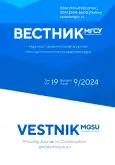Influence of the coefficient of non-uniformity of expansion of clay soil specimen on mechanical characteristics
- Authors: Ter-Martirosyan A.Z.1, Angelo G.O.1, Ermoshina L.Y.1, Bokov I.A.1
-
Affiliations:
- Moscow State University of Civil Engineering (National Research University) (MGSU)
- Issue: Vol 19, No 9 (2024)
- Pages: 1530-1540
- Section: Hydraulics. Geotechnique. Hydrotechnical construction
- URL: https://journal-vniispk.ru/1997-0935/article/view/266701
- ID: 266701
Cite item
Full Text
Abstract
About the authors
A. Z. Ter-Martirosyan
Moscow State University of Civil Engineering (National Research University) (MGSU)
Email: gic-mgsu@mail.ru
ORCID iD: 0000-0001-8787-826X
G. O. Angelo
Moscow State University of Civil Engineering (National Research University) (MGSU)
Email: nocgeo@mail.ru
ORCID iD: 0000-0002-0011-7095
L. Yu. Ermoshina
Moscow State University of Civil Engineering (National Research University) (MGSU)
Email: lyubov.ermoshina1801@mail.ru
ORCID iD: 0000-0003-1522-320X
I. A. Bokov
Moscow State University of Civil Engineering (National Research University) (MGSU)
Email: iliililia@yandex.ru
References
- Мирный А.Ю., Тер-Мартиросян А.З. Определение механических характеристик крупнообломочных грунтов прямыми испытаниями в трехосном приборе // Интеграция, партнерство и инновации в строительной науке и образовании : сб. мат. Междунар. науч. конф. 2017. С. 937–941. EDN XSNIQV.
- Ишмаев О.А., Филимонова Н.В. Результаты трехосных испытаний песков гравелистых в комплексе «АСИС» с диаметром образцов 100 мм // Известия Уральского государственного горного университета. 2022. № 2 (66). С. 89–95. doi: 10.21440/2307-2091-2022-2-89-95. EDN XNCBJY.
- Jiang C., Ding X., Chen X., Fang H., Zhang Y. Laboratory study on geotechnical characteristics of marine coral clay // Journal of Central South University. 2022. Vol. 29. Issue 2. Pp. 572–581. doi: 10.1007/s11771-022-4900-5
- Королева И.В., Сагдатова М.Р. Экспериментальные исследования поведения серых глин в условиях трехосного сжатия при разной влажности // Известия Казанского государственного архитектурно-строительного университета. 2019. № 4 (50). С. 228–235. EDN EUGJOR.
- Hernández-Hernández V.A., Joya-Cárdenas D.R., Equihua-Anguiano L.N., Leal-Vaca J.C., Diosdado-De la Peña J.A., Pérez-Moreno L. et al. Experimental and numerical analysis of triaxial compression test for a clay soil // Chilean Journal of Agricultural Research. 2021. Vol. 81. Issue 3. Pp. 357–367. doi: 10.4067/S0718-58392021000300357
- Lan L., Zhang Q., Zhu W., Ye G., Shi Y., Zhu H. Geotechnical characterization of deep Shanghai clays // Engineering Geology. 2022. Vol. 307. P. 106794. doi: 10.1016/j.enggeo.2022.106794
- Wang G., Wang Z., Ye Q., Zha J. Particle breakage evolution of coral sand using triaxial compression tests // Journal of Rock Mechanics and Geotechnical Engineering. 2021. Vol. 13. Issue 2. Pp. 321–334. doi: 10.1016/j.jrmge.2020.06.010
- Wils L., Van Impe P.O., Haegeman W. Triaxial compression tests on a crushable sand in dry and wet conditions // Proceedings of the XVI ECSMGE. Geotechnical Engineering for Infrastructure and Development. 2015. Pp. 3449–3454.
- Hazout L., Cherif Taiba A., Mahmoudi Y., Belkhatir M. Deformation characteristics of natural river sand under compression loading incorporating extreme particle diameters impacts // Marine Georesources and Geotechnology. 2022. Vol. 41. Issue 10. Pp. 1156–1174. doi: 10.1080/1064119X.2022.2122090
- Nandanwar M.R., Chen Y. Simulations of triaxial compression test for sandy loam soil using PFC3D // Paper presented at the American Society of Agricultural and Biological Engineers Annual International Meeting 2014. 2014. Vol. 6. Pp. 4097–4106.
- Kozicki J., Tejchman J., Mühlhaus H. Discrete simulations of a triaxial compression test for sand by DEM // International Journal for Numerical and Analytical Methods in Geomechanics. 2014. Vol. 38. Issue 18. Pp. 1923–1952. doi: 10.1002/nag.2285
- Benessalah I., Sadek M., Villard P., Arab A. Undrained triaxial compression tests on three-dimensional reinforced sand: Effect of the geocell height // European Journal of Environmental and Civil Engineering. 2022. Vol. 26. Issue 5. Pp. 1694–1705. doi: 10.1080/19648189.2020.1728581
- Pinho-Lopes M. Sand reinforced with recycled cotton textiles from waste blue-jeans: Stress–Strain response // International Journal of Geosynthetics and Ground Engineering. 2022. Vol. 8. Issue 5. doi: 10.1007/s40891-022-00404-z
- Pantazopoulos I.A., Markou I.N., Atmatzidis D.K. Stress-strain-strength and hydraulic performance of microfine cement grouted sands // Journal of Materials in Civil Engineering. 2022. Vol. 34. Issue 10. doi: 10.1061/(ASCE)MT.1943-5533.0004433
- Yin Z., Zhang Q., Zhang X., Zhang J., Li X. Shear strength of grouted clay: Comparison of triaxial tests to direct shear tests // Bulletin of Engineering Geology and the Environment. 2022. Vol. 81. Issue 7. doi: 10.1007/s10064-022-02739-3
- Ekinci A., Vaz Ferreira P.M., Rezaeian M. The mechanical behaviour of compacted lambeth-group clays with and without fibre reinforcement // Geotextiles and Geomembranes. 2022. Vol. 50. Issue 1. Pp. 1–19. doi: 10.1016/j.geotexmem.2021.08.003
- Sun A., Yang G., Yang Q., Qi M., Wang N., Ren Y. Experimental investigation of thermo-mechanical behaviors of deep-sea clay from the south china sea // Applied Ocean Research. 2022. Vol. 119. P. 103015. doi: 10.1016/j.apor.2021.103015
- Yan R., Yan M., Yu H., Yang D. Influence of temperature and pore pressure on geomechanical behavior of methane hydrate-bearing sand // International Journal of Geomechanics. 2022. Vol. 22. Issue 11. doi: 10.1061/(ASCE)GM.1943-5622.0002580
- Zhang C., Pan Z., Yin H., Ma C., Ma L., Li X. Influence of clay mineral content on mechanical properties and microfabric of tailings // Scientific Reports. 2022. Vol. 12. Issue 1. doi: 10.1038/s41598-022-15063-3
- Тер-Мартиросян А.З., Анжело Г.О., Ермошина Л.Ю., Боков И.А., Манукян А.В. Влияние коэффициента неравномерности расширения грунтового образца на механические характеристики // Вестник МГСУ. 2023. Т. 18. № 10. С. 1574–1586. doi: 10.22227/1997-0935.2023.10.1574-1586
Supplementary files





